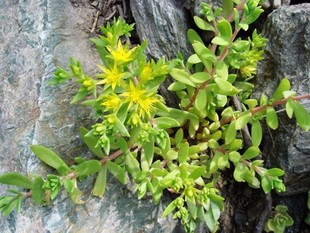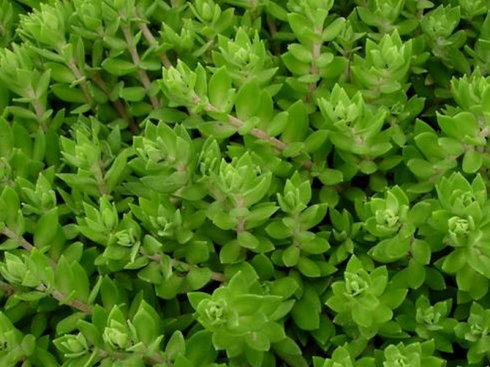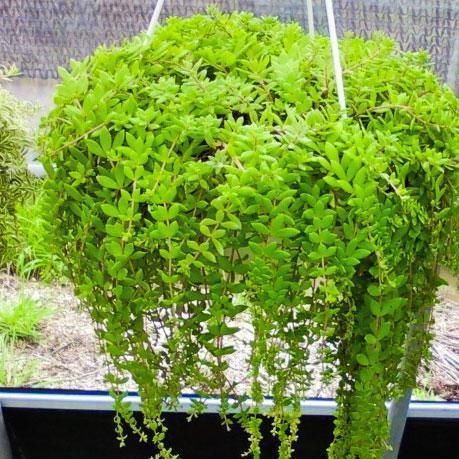Stringy stonecrop (Sedum sarmentosum) profile
Written by Maggie
Sep 14 2021

Stringy stonecrop, scientific name Sedum sarmentosum, is a perennial herb of the genus Sedum and the family Sedum. Stringy stonecrop is 9 -- 18cm tall, smooth and glabrous in the whole plant, up to 70cm long, impeller, round in shape, entire, sessile. Stringy stonecrop has small yellow star-shaped flowers in early summer. Stringy stonecrop is used for lawns, ground covers and vertical flower beds. The whole grass used in medicine has the effect of clearing away heat and detoxifying, sterilization and anti-inflammation.
Stringy Stonecrop Picture

Stringy Stonecrop Characters
Stringy stonecrop is a perennial fleshy herb, sterile branches, prostate roots, fruiting branches erect, 10 ~ 20cm long. Leaves are 3-whorled, oblate late to oblong, 15 -- 25mm long and 3 -- 5mm wide, apically acute, base tapered, entire. Cymes are loose, often 3-5 branched; Flowers of stringy stonecrop are pale yellow, sessile; Stringy stonecrop has 5 sepals, broadly lanceolate to oblong, 3.5 -- 5mm long, apex slightly obtuse; Stringy stonecrop has 5 petals, lanceolate to oblong, 5 -- 8mm long, apically lateral with a long cusp; Stringy stonecrop has 10 stamens, shorter than petals; Stringy stonecrop has 5 carpal, slightly open. Seeds are small, oval, wingless, the surface of a nipple protruding. Flowering period is in spring, fruiting period in summer.
Stringy Stonecrop Growth Habit
Stringy stonecrop (Sedum Sarmentosum) prefers warm, humid, semi-shady environments, strong adaptability, drought resistance, cold tolerance, soil selection, and grows well in loose sandy loam. Stringy stonecrop light requirements are not strict, a boat is suitable for growth in medium light conditions, but also resistant to weak light. The suitable temperature for growth is 15-25℃, and the overwintering temperature is 5℃.
How to Grow and Care for Stringy Stonecrop
Soil
Stringy stonecrop is easy to maintain, but poor soil should not be avoided in domestic cultivation, otherwise signs of weak growth and yellowing of leaves will affect the ornamental effect. Pastoral soil, neutral soil, sandy loam can grow, strong vitality, stem can root when it falls to the ground. When growing Stringy stonecrop, the soil should be an appropriate amount of organic fertilizer, after crushing cottonseed cake, sesame paste residue or chicken dung dry can be.
Temperature and Light
Temperature: The optimum growth temperature of Stringy stonecrop (Sedum Sarmentosum) is 15℃ to 28℃. Winter low temperatures will appear frostbite, and even die.
Light: Stringy Stonecrop avoids exposure to strong light and yellows its leaves when exposed to strong light. Stringy stonecrop is suitable for scattering light maintenance, appropriate shade in summer.
Sewage sludge management
Watering: Stringy Stonecrop grows fast, requires a lot of water, and grows well under certain shading conditions. Keep the soil moist.
Fertilizer: in the process of Stringy Stonecrop growth, every half a month a small amount of compound chemical fertilizer, after fertilizing water should be irrigated immediately, in case fertilizer burns stem and leaves or root system.

Stringy Stonecrop Propagation Methods
Stringy stonecrop (Sedum Sarmentosum) can be propagated by seed or asexually, i.e., by cuttings, splitting, or laying, and is highly viable.It is usually propagated by branching or cuttings. Planting should be carried out in early spring, cuttings can be at any time.
Stringy Stonecrop Common Diseases and Pests
Stringy Stonecrop Common pests: Scale insects
Common diseases of Stringy Stonecrop: grey mould, anthrax, powdery mildew
Stringy Stonecrop Landscape Utility
1. Stringy Stonecrop (Sedum Sarmentosum) is a plant material of high value because it is highly resistant to cold, high temperature, drought and humidity, free from diseases and insect pests, and can be extensively managed. Besides, Stringy Stonecrop has a long green period, dense green branches and leaves during the growth period, and bright yellow flowers during the growth.
2. Stringy Stonecrop can be used as a ground cover plant and also as a potted ornamental plant, especially suitable for hanging in front of an indoor window. Its branches and leaves hang down from the edge of the pot, which is elegant and lovely.

Read More: Stringy Stonecrop: Grow & Care for Sedum Sarmentosum
Latest Updated
- Benefits of Bugleweed - 7 Science-backed Health Benefits
- Bugleweed Dangers & Side Effects - Is It Poisonous?
- How to Plant Evergreen Trees - What You Should Know
- When to Plant Evergreens - Grow Guide for Evergreen Trees
- 12 Wonderful Evergreen Shrubs for Your Garden
- 12 Popular Evergreen Plants with Pictures for Beginners
- When And How To Prune A Lilac Bush Like a Pro
- How to Grow & Care for Lilac Vine (Hardenbergia Violacea)
- Japanese Lilac Tree (Syringa Reticulata) Care & Propagation Guide
- Shumard Oak Pros and Cons - What to Know
Popular Articles
- Winter maintenance of Antirrhinum Majus
- How to Grow Terminalia Mantaly Tree
- How to Grow and Care for Crossostephium Chinense
- How to grow Antirrhinum Majus in spring
- Peristeria Elata (Dove Orchid) Profile: Info & Care Guide
- Underwatered Snake Plant (Sansevieria Trifasciata) - Signs And How To Fix
- How to Care for Brazilian Jasmine Plant (Mandevilla Sanderi)
- How to Grow & Care for Graptopetalum Purple Delight in Summer
- Rosa Chinensis (China Rose): Plant Growing & Care Tips
- How to Care for Baby Sun Rose (Aptenia Cordifolia)